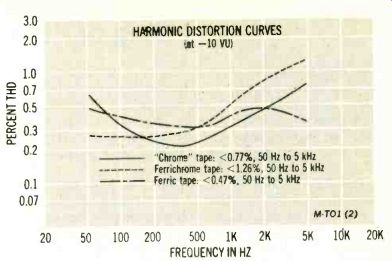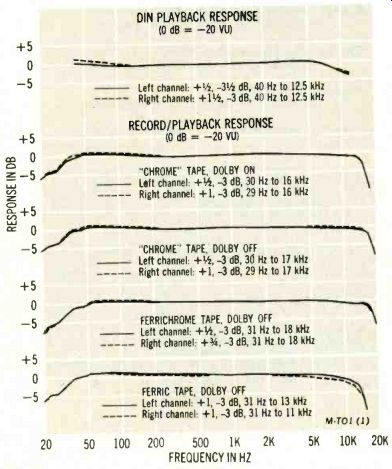It's a Good Little Deck
Mitsubishi Model M-T01 stereo cassette deck, in metal case.
Dimensions: 10 1/2 by 5 3 3/8 inches (front), 8 3/4 inches deep plus clearance for transport superstructure, controls, and connections.
Price: $560. Warranty: "limited," one year labor, two years parts. Manufacturer: Mitsubishi Electric Corp., Japan; U.S. distributor: Melco Sales, Inc., 3030 E. Victoria St., Compton, Calif. 90221.

It's a formidable problem, trimming down a cassette deck to "micro" size. The designer can do nothing about the size of the cassette itself-and that, to some extent, determines the size of the transport. Mitsubishi has fudged a bit by putting the cassette holder outside the main body of the deck, instead of building a conventional "well." (Some full-size decks use similar designs.) But it certainly has not tried to solve the space problem by nibbling away at the features; the MT01 has some that are missing from most full-size decks in this price class. And the company can't be accused of compromising performance in the search for compactness.
Response with the three tapes suggested by Mitsubishi, Sony ferrichrome, HF ferric, and TDK SA for the "chrome" settings-is consistently excellent. Not only are all three sets of curves representative of the extended high-end response available today, even without a separate playback head or gap, but they are quite flat. The SA curves are particularly flat and, partly for this reason, hold up very well indeed with the Dolby circuit turned on. The tape-motion measurements, too, are very good-thanks, in part, presumably, to the closed-loop dual-capstan drive. Noise figures are consistent with those in other decks of this class and can be improved upon slightly by riding gain a little higher than the manual's admonition to stay below the meters' 0 dB would allow. There is about 11 dB of overshoot (which is relatively little) on sudden transients, and we found that we could run the meters to about +2 dB without getting into trouble.
Audible performance is excellent, in fact, with all three tapes. While we would give the edge to SA, HF produced sound that was more quiet and brilliant than average for a ferric and the ferrichrome seemed both quieter and cleaner than average for that tape type. But the tape table in the otherwise good manual is the usual-very unfunny-joke. More than half of the listed tapes have never been offered here, are called something else in the U.S., or have been discontinued both here and abroad. BASF and 3M are the only non-Japanese companies represented; though we got excellent results with Ampex Grand Master (in the ferric settings) and Memorex High Bias ("chrome"), neither brand is mentioned. Yet the list does include tapes so disparate that, although we did not try every one, we find it difficult to believe that any single deck can give good or even acceptable results with all.
Among the features that are out of the ordinary are the memory-which offers automatic playback (START) as well as stop mode following rewind-and the two pause modes, one of which (called ASPS, for automatic spacing pause system) automatically records a blank of about three seconds before the deck actually pauses. The mike and line level controls allow mixing; each has separate elements for left and right channels, though the friction clutching is so stiff and the knobs so small that fine interchannel adjustments are exceptionally difficult.
The controls are solenoid-operated and logic-controlled.
This means, among other things, that you can go directly from one mode to another without pressing STOP. (The solenoids also save a lot of space-by comparison to mechanical "piano keys"-with their small trip buttons, which have illuminating symbols to confirm operation mode.) The PAUSE is very good for a solenoid deck: almost quick enough to prevent audible wow, and with only a moderate click on the tape when there is no input signal. In general, however, we find it easier to make edits with the mechanical pause levers that start the transport when you remove your finger; the M-T01's solenoid restarts the transport when you press the button, making split-second timing a mite more problematic.
Readers who suffer from the delusion that there is something inherently worthy about "big, professional VU meters" will look with disdain on those in the M-T01. The disdain is unwarranted. It's true that Mitsubishi's read only to -20 dB, but then, so do professional VU meters. These are peak-reading meters of excellent ballistics, big enough (if only just) to read useful data on the calibration dial. Admittedly, larger meters might have been even more useful; but we certainly prefer these over the sloppy, sluggish average-reading jobs that once were standard or the overly frenetic and essentially unreadable types that, in excessive obsequiousness to instantaneous peak values, don't dwell long enough on the maxima.
Of the front-mount (as opposed to well) transport designs, Mitsubishi's strikes us as quite good. Like some (though not all), it allows free access to the heads for maintenance. A flip-down door covers them when the deck is not in use,, and although it has openings through which dust can get in, they are reasonably small.
We would rate the M-T01 as a very good deck of its class.
Though it is only about half the bulk of the typical $500 deck of comparable features, performance is solid and good human engineering of the faceplate has packed in a lot of elements without serious crowding or over-miniaturization. It is a little more costly and a little less convenient than one would expect a comparable full-size deck to be; but the differences are not great, and its compactness may count for many as a more-than-compensatory virtue on crowded equipment shelves.
Mitsubishi M-T01 Cassette Deck
Speed accuracy 0.43% fast at 105, 120, 8 127 VAC Wow and flutter (ANSI/IEEE weighted peak) playback t 0.06% average ± 0.09% max. instantaneous record/play 10.07% average 10.10% max. instantaneous S/N ratio (re DIN 0 dB; A-weighting) "chrome" FeCr playback 60 1/4 dB 61 1/4 dB Dolby playback 67% dB 68 1/4 dB record/play 57 dB 58 dB Dolby record/play 64 dB 65 dB Erasure (333 Hz, re DIN 0 dB)
Channel separation (r/p, 333 Hz)
Meter indication for DIN 0 dB 71 1/. dB 48 1/4 dB +2 dB
Meter indication for 3% THD (at 333 Hz)
"chrome" tape + 11 ferrichrome tape +5 1/2 ferric tape + 2 ¼
Sensitivity (re DIN 0 dB) line
Input mike input dB dB dB 130 mV
0.12 mV
Mike input overload (clipping) 17.5 mV
Output (from DIN 0 dB) 0.51 V ferric 58 dB 65% dB 54 1/4 dB 62'1 dB
DIN PLAYBACK RESPONSE (0 dB =-20 VU)
HARMONIC DISTORTION CURVES Let -10 VU)


Also see:
Mitsubishi Model M-F01 stereo FM tuner (review, Jun. 1979)